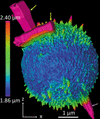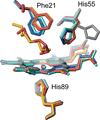issue contents
September 2022 issue

scientific commentaries
CHEMISTRY | CRYSTENG
The perovskites are an intensely studied class of materials, with a breadth of possible compositions made even wider by the possibility of incorporating molecular ions. Here the context is discussed of a newly reported metal-free perovskite with the H3O+ ion on the B site.
BIOLOGY | MEDICINE
The unexpected findings that are described by Czub et al. [IUCrJ (2022), 9, 551–561] provide a very interesting study demonstrating how small differences in structure can result in significant changes in the relative affinities of the seemingly promiscuous binding sites that are seen with serum albumins.
research letters
CHEMISTRY | CRYSTENG
Commercial X-ray scattering instruments were assessed for their ability to perform rapid flow-based structural analysis using micro- and millifluidic sample environments. These studies demonstrate that serial collection of small- and wide-angle X-ray scattering data from small-molecule crystals and nanoparticles is now possible with laboratory instruments.
research papers
CHEMISTRY | CRYSTENG
Download citation


Download citation


A metal-free and ammonium-free perovskite ABBr−3 (where A = 1,4-diazabicyclo[2.2.2]octane dication and B = H3O+) has been obtained in two forms: polymorph α with corner-sharing, and polymorph β with face-sharing octahedra [H3O+]Br6.
BIOLOGY | MEDICINE
Ketoprofen exhibits different binding-site preferences when interacting with mammalian albumins from different species. The drug-binding properties of albumins cannot easily be predicted based only on a complex of albumin from another species even when the drug-binding sites exhibit a high degree of conservation between species.
PDB reference: human serum albumin, complex with ketoprofen, 7jwn
BIOLOGY | MEDICINE
The neutron crystallographic structure of an Hsp72–ADP complex is reported.
CHEMISTRY | CRYSTENG
Download citation


Download citation


Accurate crystal structures of H2O, D2O and mixed (50%H2O/50%D2O) ice VI obtained by Hirshfeld atom refinement (HAR) of high-pressure single-crystal synchrotron and laboratory X-ray diffraction data are presented. It was possible to obtain O—H bond lengths and anisotropic displacement parameters for disordered hydrogen atoms which are in good agreement with the corresponding results of single-crystal neutron diffraction data. These results show that HAR combined with X-ray diffraction can compete with neutron diffraction in detailed studies of polymorphic forms of ice and crystals of other hydrogen-rich compounds.
NEUTRON | SYNCHROTRON
Coherent X-ray diffraction imaging and 3D X-ray fluorescence were used to visualize in 3D the self-transformation of polycrystalline microspheres of calcium carbonate into hollow and core-shell microspheroid hierarchical structures.
MATERIALS | COMPUTATION
An approach is described to study texture in nanostructured materials by utilizing the 3D pair distribution function. It is demonstrated how to measure, process and analyze data to obtain the textured 3D pair distribution function on a fiber-textured platinum thin film.
CHEMISTRY | CRYSTENG
Download citation


Download citation


Refined anomalous dispersion values provide an easy and reliable way to correct for inelastic scattering effects of the electronic environment unique to each structure. Herein, we introduce the implementation of this refinement in OLEX2 and discuss its usage and perspectives.
BIOLOGY | MEDICINE
The determination of the structure of the multifunctional globin dehaloperoxidase using multiple room-temperature methods is described. Structures obtained by serial femtosecond crystallography, serial synchrotron crystallography, neutron diffraction and serial Laue crystallography are compared and two oxidation states of the enzyme are contrasted.
PDB references: ferric DHP-B, neutron diffraction structure, 7jor; X-ray structure from crystal used for neutron diffraction, 7kfm; serial femtosecond crystallography structure, 7adf; serial synchrotron crystallography structure, 7acp; serial Laue crystallography structure, 7adq; oxyferrous DHP-B, joint X-ray/neutron structure, 7kcu; serial femtosecond crystallography structure, 7adx
BIOLOGY | MEDICINE
The crystal structure of HipAN, an unusual N-terminal component of the HipA toxin from Haemophilus influenzae, was determined at 2.70 Å resolution. A combined study on this unique three-component HipBA toxin–antitoxin system provides further insights into the regulatory mechanism of the HipBA toxin–antitoxin system.
PDB reference: N-terminal domain of HipA toxin, 7czo
CRYO | EM
This article explores the use of the deep learning approach deepEMhancer as a regularizer in the RELION refinement process. deepEMhancer introduces prior information derived from macromolecular structures and contributes to noise reduction and signal enhancement, as well as a higher degree of isotropy, with a direct effect on image alignment and a reduction of overfitting during iterative refinement.
CHEMISTRY | CRYSTENG
The geometric criteria for defining attractive water–water interactions should be broader than the classical hydrogen-bonding criteria given that attractive antiparallel interactions also exist.
BIOLOGY | MEDICINE
This paper describes a practical method for ab initio phasing of diffraction data collected from high-solvent-content protein crystals (solvent content >70%). Unlike traditional direct methods, this procedure leverages the powerful constraint of solvent flatness, and works at the modest resolutions (2.0–3.5 Å) and with the large numbers of atoms, that are typical of protein crystallography.
BIOLOGY | MEDICINE
Download citation


Download citation


The recently discovered lytic polysaccharide monooxygenases (LPMOs) are Cu-containing enzymes capable of degrading polysaccharide substrates oxidatively. Here we have monitored the Cu-site geometry in two AA9 LPMOs, one from Lentinus similis (LsAA9_A) and one from Thermoascus aurantiacus (TaAA9_A), as the active-site Cu is photoreduced in the X-ray beam. In addition, we have characterized in detail the structural effects of oligosaccharide binding in differently photoreduced states of LsAA9_A.
PDB references: LsAA9_A(f), 7pxi; 7pxj; 7pxk; 7pxl; 7pxm; 7pxn; RT, 7pxr; RT (synchrotron), 7pxs; reduced with ascorbic acid, low X-ray dose, 7pxu; reduced with ascorbic acid, high X-ray dose, 7pxv; SSX, 7pxt; complex with cellotetraose, 7pyd; 7pye; 7pyf; 7pyg; 7pyh; 7pyi; LsAA9_A(Ec), 7pyl; 7pym; 7pyn; 7pyo; 7pyp; 7pyq; 7pqr; complex with cellotriose, 7pyu; 7pyw; 7pyx; 7pyy; 7pyz; 7pz0; complex with cellotetraose, 7pxw; TaAA9_A, 7pz3; 7pz4; 7pz5; 7pz6; 7pz7; 7pz8
BIOLOGY | MEDICINE
X-ray crystallography at variable temperature for SARS-CoV-2 Mpro reveals a complex conformational landscape, including a mobile metal at the catalytic dyad, mercurial conformational heterogeneity at various sites, and an intramolecular network bridging the active site and dimer interface.
ELECTRON CRYSTALLOGRAPHY
The stacking fault probability in submicrometre-sized crystals of Li1.2Ni0.13Mn0.54Co0.13O2 was refined through the quantitative analysis of diffuse electron scattering.
MATERIALS | COMPUTATION
A model has been developed for refining rigid octahedral rotations in perovskites and demonstrated to model pair distribution function data of CaTiO3.


 journal menu
journal menu




 access
access
































